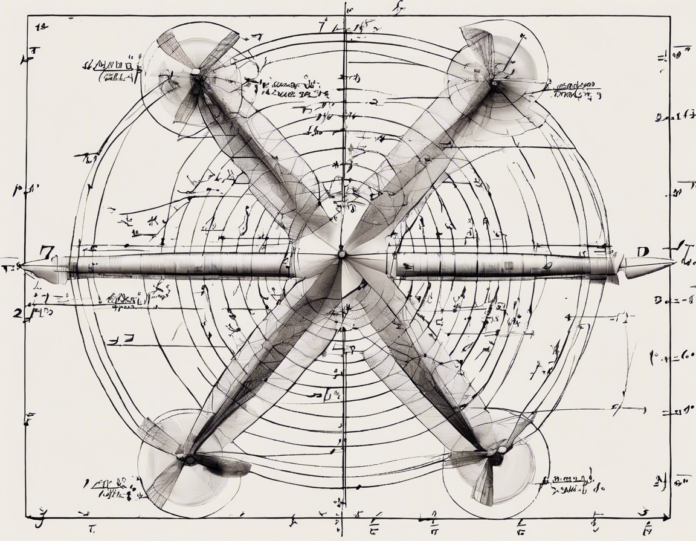In the realm of three-dimensional geometry, planes play a vital role in understanding shapes, lines, and volumes. A plane can be defined as a two-dimensional flat surface that extends infinitely in all directions. In a 3D space, a plane is determined by a point and a normal vector.
Equation of a Plane
The equation of a plane in three-dimensional space can be expressed in various forms, depending on the information available. One common form is the scalar equation of a plane, given by:
[ Ax + By + Cz = D ]
Where ( A ), ( B ), and ( C ) are the coefficients of ( x ), ( y ), and ( z ), respectively, and ( D ) is a constant. This equation represents all the points ( (x, y, z) ) that satisfy the equation, and hence lie on the plane.
Another way to represent a plane is using the vector equation of a plane. This form involves a point ( P ) in the plane and two direction vectors ( \vec{v} ) and ( \vec{w} ) that are parallel to the plane. The vector equation of a plane is given as:
[ \vec{r} = \vec{a} + s\vec{v} + t\vec{w} ]
Where ( \vec{r} ) is the position vector of a general point in the plane, ( \vec{a} ) is the position vector of the point ( P ), and ( s ) and ( t ) are scalar parameters.
Finding the Equation of a Plane
To find the equation of a plane, you typically need either:
1. Three non-collinear points on the plane or
2. A point on the plane and a normal vector to the plane.
Using three non-collinear points ( (x_1, y_1, z_1) ), ( (x_2, y_2, z_2) ), and ( (x_3, y_3, z_3) ), the normal vector ( \vec{n} ) to the plane can be found as the cross product of the vectors formed by the points:
[ \vec{n} = (x_2 – x_1, y_2 – y_1, z_2 – z_1) \times (x_3 – x_1, y_3 – y_1, z_3 – z_1) ]
Once you have the normal vector, you can use the point-normal form of the equation of a plane:
[ \vec{n} \cdot (x – x_1, y – y_1, z – z_1) = 0 ]
Expanding this equation gives the equation of the plane in the form ( Ax + By + Cz = D ), where ( A ), ( B ), and ( C ) are the components of the normal vector, and ( D ) is the constant term.
Standard Form of the Equation of a Plane
The equation of a plane can also be expressed in standard form:
[ Ax + By + Cz + D = 0 ]
This form has advantages for certain computations, such as determining the distance between a point and a plane.
Properties of a Plane
Planes in 3D space exhibit several interesting properties and relationships:
– Parallel Planes: Two planes are parallel if their normal vectors are parallel.
– Perpendicular Planes: Two planes are perpendicular if their normal vectors are perpendicular, implying the planes are at a right angle to each other.
– Angle between Planes: The angle between two planes is defined as the angle between their normal vectors.
– Distance from a Point to a Plane: The distance ( D ) from a point ( P(x_0, y_0, z_0) ) to a plane in standard form is given by:
[ D = \frac{|Ax_0 + By_0 + Cz_0 + D|}{\sqrt{A^2 + B^2 + C^2}} ]
Understanding these properties is crucial for working with planes in 3D space effectively.
Applications of the Equation of a Plane
The equation of a plane finds applications in various fields, including:
1. Computer Graphics: Rendering three-dimensional objects on a two-dimensional screen involves computations based on planes.
2. Physics: Analyzing forces, motion, and interactions in the physical world often requires understanding planes and their relationships.
3. Engineering: Designing structures, analyzing stresses, and modeling systems frequently involve working with planes in 3D space.
Having a solid grasp of the equation of a plane is fundamental in these and many other fields that deal with spatial relationships.
Frequently Asked Questions (FAQs)
Q1: How do you determine if a point lies on a plane?
A: To check if a point ( (x_0, y_0, z_0) ) lies on a plane with equation ( Ax + By + Cz = D ), substitute the coordinates of the point into the equation. If the equality holds, the point lies on the plane.
Q2: Can a plane be defined by a single point and a vector not normal to the plane?
A: No, a plane is uniquely defined by a point in the plane and a normal vector that is perpendicular to the plane.
Q3: How do you find the intersection of two planes?
A: To find the intersection of two planes, solve the system of equations formed by the equations of the two planes simultaneously. The solution gives the line of intersection, or if the planes are parallel, there will be no solution.
Q4: What is the significance of the normal vector in the equation of a plane?
A: The normal vector is crucial as it is perpendicular to the plane. It determines the orientation of the plane in space and is used in calculating properties like angle between planes and distance from a point to a plane.
Q5: Why is the standard form of the equation of a plane useful?
A: The standard form is beneficial for computations such as calculating distances between points and planes, determining intersections with other planes, and understanding the overall orientation of the plane.
Understanding the equation of a plane in 3D space is fundamental in geometry, physics, engineering, and various other disciplines where spatial relationships are essential. By grasping the various forms and properties of planes, one can navigate and manipulate objects and concepts in three-dimensional space with confidence and accuracy.
